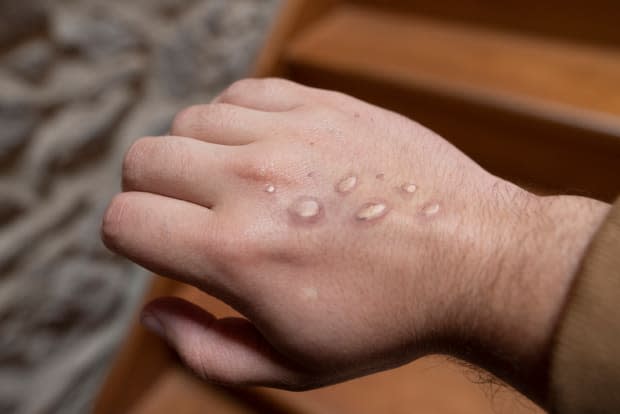Here's Exactly What a Monkeypox Rash Looks Like, According to Dermatologists
The recent monkeypox outbreak has seen many headlines for the painful rash that it causes. And with those headlines comes a lot of confusion and curiosity about how a monkeypox rash typically appears.
“In past monkeypox outbreaks, symptoms would start with a fever and often flu-like symptoms, and a rash followed,” explains Dr. Hadley King, MD, a board-certified dermatologist practicing in New York City. “The rash would typically start on the face and then spread to many areas of the body, and people usually developed between 10 and 150 monkeypox bumps.”
However, in the current monkeypox outbreak, the signs and symptoms are a bit different.
“Affected people may not develop fever or flu-like symptoms, and it's more common for them to have fewer bumps on their skin,” says Dr. King. “People may have only one or two bumps.”
Adds Susan Massick, MD, a board-certified dermatologist and Associate Professor of Dermatology at The Ohio State University College of Medicine, "Like other pox infections of the skin, there is a natural evolution in the skin findings, starting with a papule, or bump on the skin, that then blisters (vesicle) or looks like a pustule, that then scabs, and eventually heals over the course of two to three weeks.”
Related: Everything You Need to Know About Monkeypox
What Does a Monkeypox Rash Look Like?
According to Dr. King, the rash may start in the groin, genital area (penis, testicles, labia and vagina), or around the anus–and it may not spread. Specifically, the Centers for Disease Control and Prevention note that the rash may also appear on other areas like the hands, feet, chest, face, or mouth.
“But even if there are only a few bumps, they can still be very painful,” says Dr. King. “The bumps can look like blisters, pus-filled bumps, or open sores.”
Dr. Massick adds that these mucosal lesions are “small, painful ulcerations on the mucous membranes, sometimes white or red in color but typically painful with swelling.”
However, she adds that the bumps may be in various stages of evolution—bump, blister/pustule, scab/crust, then slow healing sometimes with scar or discoloration—and not all will appear at the same time, and may not all crust over at the same time.

iStock
“The rash will often increase in intensity and the number of skin lesions will increase with worsening symptoms of pain/discomfort/swelling,” says Dr. Massick.
She also notes that the skin lesions may be solitary or in clusters, may be localized —just in one body area—or more generalized/widespread, and that it typically runs its course within three to four weeks.
Related: Do You Need the Monkeypox Vaccine?
What to Do If You Think You Have Monkeypox
If you suspect you may have monkeypox, the CDC recommends that you seek medical care immediately if you develop a new, unexplained skin rash or lesions on any part of the body.
Related: What Are the First Symptoms of Monkeypox?
“This could be your dermatologist, your primary care doctor, or an urgent care center,” says Dr. King. “If monkeypox is suspected, a skin lesion will be swabbed, and the swab will be sent to a lab to do a PCR test for monkeypox. If you are seen by a non-dermatologist and further diagnostic or management help is needed, you may be referred to a dermatologist.”
Once you are tested and have a confirmed case of monkeypox, Dr. Massick adds that you may still be contagious for up to 21 days or more.
Next up: Everything You Need to Know About the Novavax COVID Vaccine
Sources
Dr. Hadley King, MD, a board-certified dermatologist practicing in New York City.
Susan Massick, MD, a board-certified dermatologist and Associate Professor of Dermatology at The Ohio State University College of Medicine.
